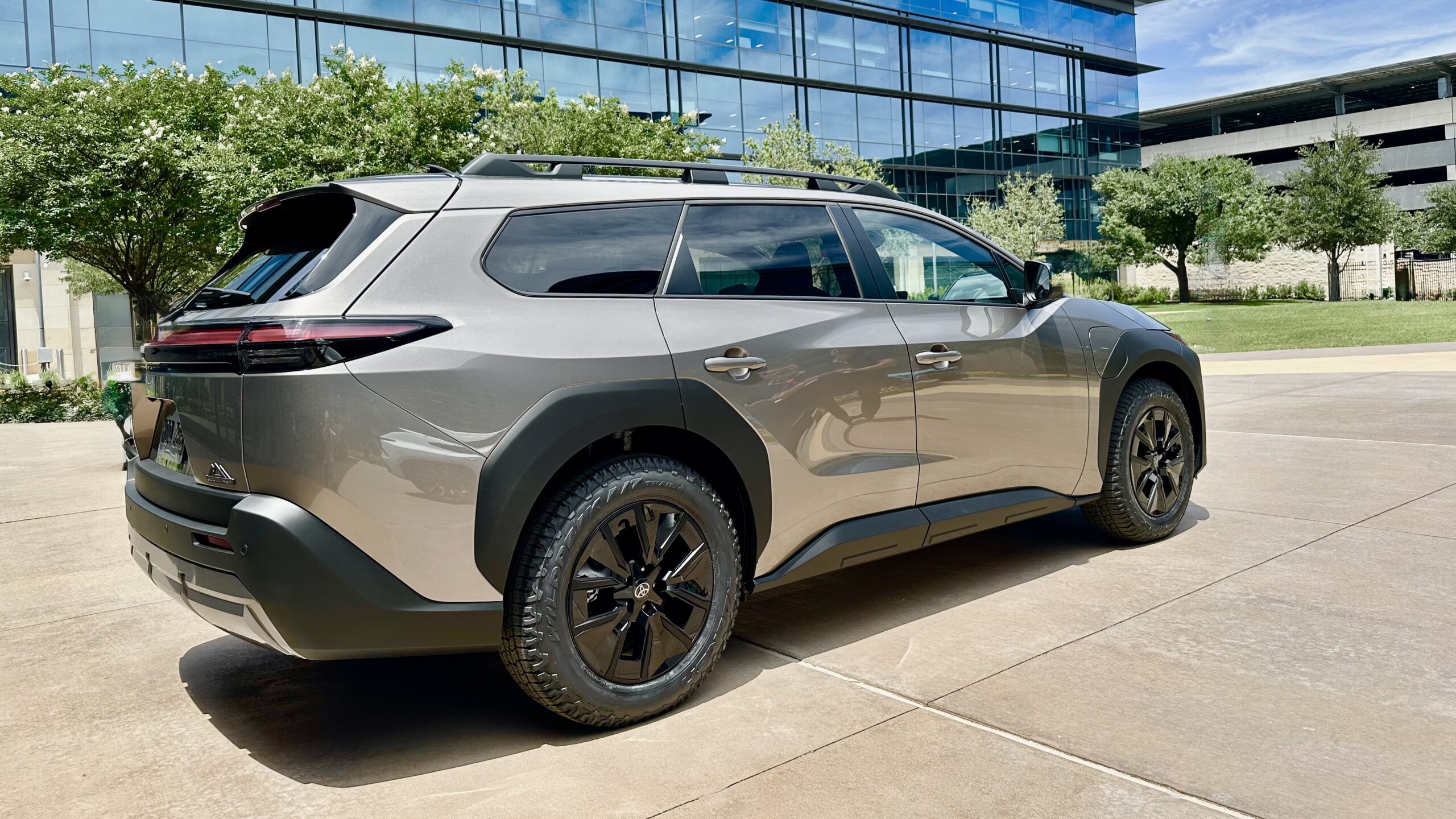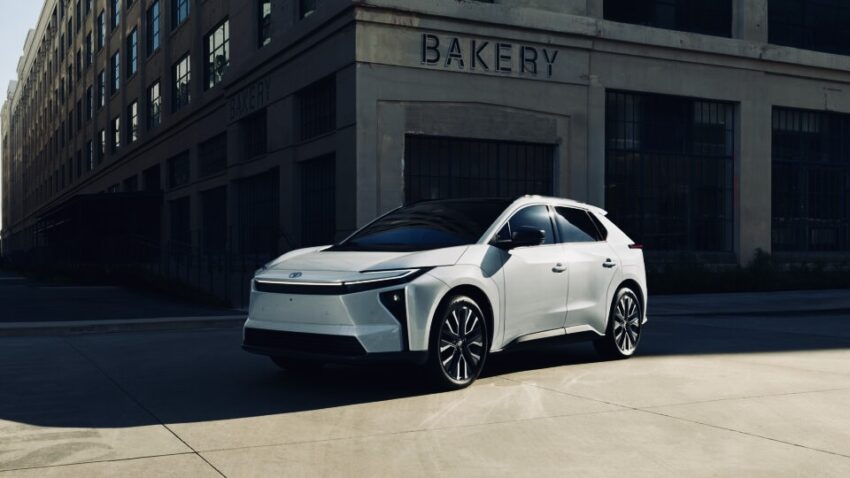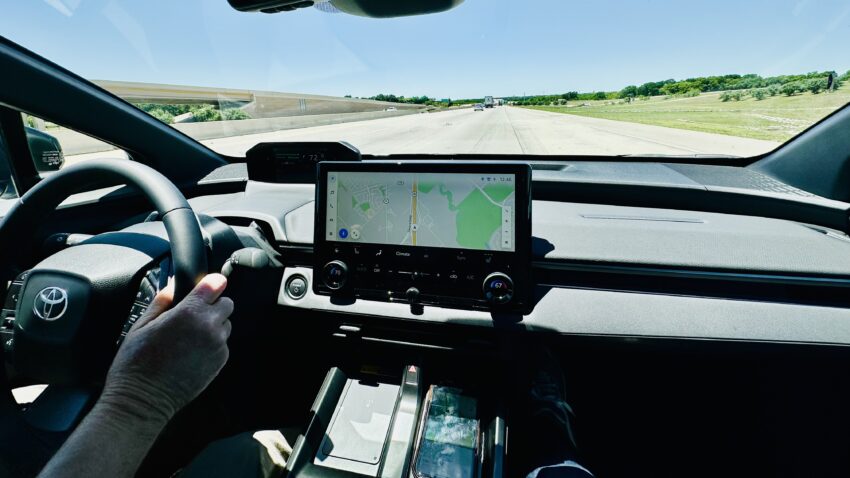
Toyota did a lot more than chop the name in half and ditch some of the cladding for its 2026 bZ compact electric crossover.
While it looks pretty much the same as the original 2022 bZ4X, the 2026 bZ gets a ton of improvement where it counts – more range, more power, faster charging, better balance and improved handling. Elimination of that clunky black over-fender with three of the five exterior color choices also provides an overall cleaner, smoother look.
We got the basic info on the new bZ earlier, but weren’t able to get behind the wheel until Toyota rolled out a batch of them at its headquarters in Texas, recently.
The official drive was pretty much confined to city streets – although we took a longish freeway “detour” so we could experience the bZ in both city and highway driving conditions.
First impressions
Although the body’s the same, this is really a whole new vehicle, and a much better one than the ’22 to ’25 bZ4Xs.
We found those to be comfortable but bland and pretty pokey with wholly inadequate range – 222 to 252 miles – in a segment whose leaders hit or surpass the 300-mile mark. Those days are gone, though.
The drives were short, but we were able to test several versions of the 2026 bZ and found it to be quite peppy, except in the base model, a single-motor front-drive XLE with a smallish 57.7 kilowatt-hour battery and just 168 hp.
No other version of the bZ disappointed.
Toyota tweaked motors, axles and batteries in its bZ re-do and the result is a vehicle that handles better and with truer steering feedback than its predecessor. There’s also enough power now to make the drive fun, which will be nice on those on curvy country and twisty mountain roads we didn’t get to experience in the oh-so-flat neighborhood around Toyota HQ in the appropriately named city of Plano.

The 2026 bZ’s ride is a bit stiff – but only a bit – and we didn’t experience much in the way of body roll on those corners we did manage to zip around. There’s a nice level of soundproofing so road noise wasn’t terribly intrusive, and the seats were supportive yet comfortable.
Our biggest gripe is that Toyota doesn’t seem to like one-pedal driving, so the bZ retains a multi-step approach to regenerative braking, with even the fiercest level insufficient to bring the vehicle to a halt.
It’s also a system that resets itself to zero each time the wheels stop rolling, so drivers have to train themselves to flick through the stages to find their favorite regen level after every stop. We like to use full-stop regenerative braking, or one-pedal driving, as a replacement for downshifting. In the bZ, the regen levels just aren’t hefty enough to do the job well.
We didn’t get sufficient driving time to test the bZ’s real-world range but hope to be able to do that closer to its midsummer launch.
Powering the bZ
Toyota gave every version but that base XLE heftier 74.7 kWh batteries for 2026, alsong with a boost in horsepower ranging from a 10% bump for the single-motor XLE FWD Plus and Limited versions to 50% – or more – for dual-motor, all-wheel drive trims. That “or more” is there because while the two mainstream all-wheel drive XLE and Limited trims see the 50% hike, a new outdoor-themed Woodland trim is rated by Toyota at an impressive 375 hp.
While the extra oomph gives the Woodland an impressive 4.7-second 0-60 time, the real benefit is that it also provides more torque for slogging through deep sand or mud, and more overall power for towing.
The Woodland is tow-rated at up to 3,500 pounds, which is a small camping trailer, a medium teardrop trailer or a pair of jet-skis and their trailer. Unfortunately the Woodland’s extra power also means less range, a Toyota-rated 260 miles. That drops, likely to between 130 and 180 miles, when towing – especially at highway speeds.
Oddly, given its name and off-roady design features, the Woodland doesn’t come with all-terrain tires. Adding those – they are offered as an option – will also affect range, and not in a good way. The Woodland also doesn’t come with much in the way of improved ground clearance – 8.3 inches versus 8.2 inches for the “regular” bZ trims.
We found the Woodland to be as quick as Toyota advertised, and the other AWD versions not far behind, with estimated 4.9-second times for the 0-60 sprint.
(We drove the 471-horsepower Lexus LC500 convertible right after stepping out of the bZ Woodland and found the the bZ to be just as quick although without the aural thrill of the Lexus’s growling, naturally aspirated V8.)
The bZ Woodland, btw, is Toyota’s version of the Subaru Trailseeker, just as the rest of the all-wheel drive bZ lineup corresponds to Subaru’s Solterra. All are the result of an EV collaboration between the two companies (Toyota’s a major investor in Subie and Subaru is a memvber of the Toyota Group) and they share the same co-developed platform, Toyota’s battery and electric drive systems and Subaru’s world-class all-wheel drive system with its traction and control-bolstering X-Mode.
Toyota hasn’t yet released torque figures for the bZ trims. Those, along with pricing and official EPA range estimates, are expected closer to the mid-summer on-sale date.
Toyota bZ Range and Charging
For 2026, the front-drive, single-motor XLE FWD Plus trim gets a Toyota-estimated 314 miles of range, up from 252, while the standard all-wheel drive versions deliver either 288 miles, up from 228, for the XLE, or 278 miles, up from 222,
The base XLE, available only with front-drive, is rated at 235 miles and there’s no 2025 version for comparison. The Woodland, also new for 2026, is Toyota-rated at up to 260 miles.
also new for 2026 is the bZ’s charging capability. Like many ogher automakers, Toyota has opted to adopt the Tesla-designed NACS charging system for 2026 and beyond, so the bZ gets a NACS – North American charging standard – port that enables it to take advantage of Tesla’s Supercharger fast-charge network. It can also use CCS (non-Tesla) DC fast chargers via an adapter Toyota provides with each vehicle.
For the Level 2, or 240-volt charging, that’s the norm at home, in the workplace or at a number of the public destination and convenience charging spots – usually found at restaurants, hotels, amusement parks and shopping centers – the bZ gets a more powerful 11-kW on-board charger for 2026, up from 6.6 kW. It can plug directly into Tesla Level 2 chargers or, with a Toyota-supplied adapter, into “other” chargers with J1772 connectors.
The bZ’s maximum charging intake capacity when using a fast charger is 150 kW, and a 90% depleted battery can be refilled to 80% of capacity in about 30 minutes, no matter whether on a Supercharger or a CCS -style fast charger. for Level 2 charging, it will take about 7.5 hours to bring a 0% depleted battery back to 100% of capacity. For Level 1 charging, which uses standard 120-volt household current, figure around 2.5 days for a full recharge.
Inside the bZ
There’s still no glove box, but otherwise the 2026 Toyota bZ gets a nicely refreshed interior featuring a pair of wireless phone charging pads mounted side-by-side at the front edge of the two-level center console, along with a new 14-inch infotainment screen, up from 12.3 inches, that houses most vehicle controls including those for the climate system – which used to be physical buttons on the lower dash (there still are physical knobs for the temperature settings).

There’s ambient lighting with a whole lot of color choices, and a six-speaker sound system – with an eight-speaker JBL system available for the Limited trim. The faux leather-wrapped steering wheel is heated, as are the front seats.
Front seats also are ventilated in the Limited trim, which gets heated rear seats, too along with and a foot and leg radiant heater where the glove box would be, if there was one.
All trims get an 8-waypower adjustable driver’s seat; the Limited adds 8-way power adjustability to the front passenger seat while other trims get a manually adjustable front passenger seat.
Seats are upholstered in a combination of fabric and faux leather in the XLE trims, in faux leather in the Limited and Woodland trims.
The Woodland trim gets a panoramic roof, also standard on the Limited but an option on other trims, as well as the option of the JBL sound system.
There’s dual Bluetooth capability, allowing two phones to be connected, and there’s wireless Android Auto and Apple CarPlay capability.
The front seating area gets two 15-watt USB-C ports and a 12-volt,120-watt AC outlet, while the rear seating area gets a pair of 60 watt USB-C ports.
Toyota provides trial memberships of varying length for several connected services including Wi-Fi hot spot, Cloud Navigation for mapping and route guidance, and Intelligent Assist for voice commands.
Safety and the Toyota bZ
The 2025 bZ4X received a five star overall crash test rating from the National Highway Traffic Safety Administration – four of five stars for rollover protection – and got top “good” ratings in almost all of the nonprofit Insurance Institute for Highway Safety’s crash test and safety system evaluations – and a middle “average” rating in the few it didn’t ace. The 2026 bZ isn’t an identical twin to the ’25 model, but most structural elements are the same so we expect it to do as well if tested by either group.
All bZ trims get Toyota’s Safety Sense 3.0 suite of advanced safety and driver assistance features, including front collision avoidance and mitigation with pedestrian detection, lane departure alert with steering assist, lane following assist, rear blind spot monitor with cross-traffic alert, and dynamic cruise control with full stop-and-go function.
The Limited and Woodland trims also get lane change and traffic jam assist, front cross-traffic alert and advanced parking assist, and a panoramoic view monitor with 360-degree overhead and curb views.

Another look at 2026 bZ’s front interior/Toyota
